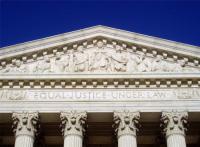-
Brazil lends $895 million to Rio de Janeiro for Olympics security
Brazil’s government has loaned 2.9 billion reais ($895 million) to the state of Rio de Janeiro to cover some of the security costs of the Olympic Games, which open on 5 August. The state of Rio de Janeiro last week declared a state of fiscal emergency. Government officials said the loan was meant to guarantee safety and security at the Olympic Games. As many as half a million foreign visitors are expected to arrive in Rio during the state’s worst financial crisis in decades.
-
-
State budgets $10 million for earthquake early warning
Governor Jerry Brown has signed a 2016-17 state budget that provides $10 million to help launch a statewide earthquake early-warning system. Although California passed a mandate in 2013 to create a statewide earthquake warning system, this is the first money appropriated by the state to make it a reality. The federal government has already provided $13.2 million to improve and test a prototype West Coast early-warning system, but this is much less than the $38 million in buildout costs and $16 million per year in operating costs needed to establish a fully functioning system serving California, Oregon, and Washington.
-
-
Supreme Court: Domestic violence perpetrators can be banned from buying, owning guns

The supreme court has ruled that individuals convicted of a domestic violence “misdemeanor” can be prohibited from owning or purchasing a gun. Previous law stated that only those convicted of intentional abuse would be barred from owning weapons, but a “reckless” assault could be pardoned. In the United States, around five women a day are shot to death by current or former intimate partners. At least 52 percent of American women murdered with guns every year are killed by intimate partners or family members.
-
-
French beaches to be patrolled by armed police lifeguards
The vacation season in France is about the start, and the French authorities have decided to place armed police lifeguards – who will also wear bullet-proof vests — on the country’s busiest beaches amid fears that terrorists may target beachgoers and vacationing families. Islamist terrorists have recently attacked beach resorts in Tunisia and Ivory Coast.
-
-
Hawaii becomes first state to place gun owners – both residents and visitors -- in a federal database
Hawaii has become the first U.S. state to place its gun owners on a federally managed database — the FBI’s “Rap Back” criminal monitoring system — and monitor them for criminal activity. The new law would permit Hawaii police to determine whether gun owners ought to be allowed to keep possession of a firearm following an arrest.
-
-
Laser uranium enrichment technology may create new nuclear proliferation risks
A new laser-based uranium enrichment technology is based on a new uranium separation concept, which relies on the selective laser excitation and condensation repression of uranium-235 in a gas. Experts worry that this new enrichment technology may provide a hard-to-detect pathway to nuclear weapons production.
-
-
Eyewitnesses who collaborate make fewer mistakes in police interview

Two recent studies show that witnesses make fewer errors when they are interviewed together than when they are interviewed separately. This stands in sharp contrast with current police guidelines to always interview witnesses separately.
-
-
Looking for ways to predict response to hurricane evacuation orders
Millions of people will likely be in harm’s way as a new hurricane season unfolds in the United States. The National Oceanic and Atmospheric Administration predicts up to eight hurricanes in the 2016 season, and as many as four major storms with winds of 111 miles per hour or more. What people do – or do not do – to get out of harm’s way is of keen interest to disaster and emergency response officials. Plans and contingencies work best when they are based on reliable predictions.
-
-
License and registration, please: how regulating guns like cars could improve safety
In the midst of the Senate’s failure to agree on measures designed to tighten controls around the sales of firearms, a new idea is emerging: Regulating guns like cars. In some regards, we are already there. Operating a firearm, like operating a motor vehicle, requires a license in many jurisdictions. Certain types of criminal offenses – domestic violence in the case of firearms, drinking and driving in the case of automobiles – can result in a suspension or revocation of that license. These rules focus on the competency of users. Regulating guns like cars is a more tried and true approach to managing dangerous technologies than the simplistic prohibitionist logic of simply keeping guns away from those we categorize as “the bad and the mad.”
-
-
Iran’s use of civilian planes to arm Assad could jeopardize $25B Boeing deal
The $25 billion aircraft deal that Boeing recently struck with Iran could be jeopardized by Tehran’s continued support of Syrian dictator Bashar al-Assad. Boeing’s jets will be sold to the state-owned Iran Air, which was sanctioned by the Treasury Department in 2011 partially due to its transport of “potentially dangerous Islamic Revolutionary Guard Corps (IRGC)-related cargo” and “missile or rocket components” to Syria. A Western intelligence report seen by Reuters in 2012 noted that Iran continued using civilian aircraft to transport large amounts of arms and personnel to aid Assad.
-
-
Australia 20 years after gun reform: No mass shootings, declining firearm deaths
Australia introduced unprecedented gun laws following a mass firearm shooting in April of 1996. Since these major gun law reform twenty years ago, Australia has seen no mass shootings and an accelerating decline in intentional firearm deaths, the Journal of the American Medical Association reports. “The absence of mass shootings in Australia in the past two decades compares to thirteen fatal mass shootings in the eighteen years prior to these sweeping reforms,” says one of the study’s authors.
-
-
Intelligence agencies spy on our data by manipulating computer chips
Researchers work to develop mechanisms that will render the Internet of Things more secure. They focus on a specific security gap: the manipulation of computer chips, that is, hardware components. These components can be found not only in PCs and laptops, but also in all other devices with integrated electronics; those include credit cards, cars, and smartphones, as well as large industrial facilities and medical equipment.
-
-
Community policing practices to prevent violent extremism
A new manual designed for police departments identifies a set of promising practices for using community policing to prevent violent extremism. “Creating a comprehensive community outreach program can build the kind of trust necessary to combat violent extremism,” said the manual’s lead author.
-
-
Integrating military, civilian trauma care systems could prevent up to 20% of U.S. trauma deaths
The leading cause of death for Americans under the age of 46 is trauma — a disabling or life-threatening physical injury that results from an event such as a motor vehicle crash, gun violence, or fall. In 2013, trauma cost approximately $670 billion in medical care expenses and lost productivity. Of the 147,790 U.S. trauma deaths in 2014, as many as 20 percent — or about 30,000 — may have been preventable after injury with optimal trauma care. Mass casualty incidents and increasing foreign and domestic threats to homeland security lend urgency to the translation of wartime lessons to civilian trauma systems, says a new report.
-
-
White House: Uranium discovered by IAEA likely tied to Iran’s nuclear weapons program

Obama administration officials concluded that particles of uranium found at Iran’s Parchin military base and revealed in the International Atomic Energy Agency’s final report on the country’s past nuclear activities were likely tied to the regime’s nuclear weapons program. The admission further underscores concerns that the IAEA’s investigation into Iran’s nuclear activities at Parchin should not have been closed following the report’s publication.
-
More headlines
The long view
Factories First: Winning the Drone War Before It Starts
Wars are won by factories before they are won on the battlefield,Martin C. Feldmann writes, noting that the United States lacks the manufacturing depth for the coming drone age. Rectifying this situation “will take far more than procurement tweaks,” Feldmann writes. “It demands a national-level, wartime-scale industrial mobilization.”
How Male Grievance Fuels Radicalization and Extremist Violence
Social extremism is evolving in reach and form. While traditional racial supremacy ideologies remain, contemporary movements are now often fueled by something more personal and emotionally resonant: male grievance.
The Surprising Reasons Floods and Other Disasters Are Deadlier at Night
It’s not just that it’s dark and people are asleep. Urban sprawl, confirmation bias, and other factors can play a role.
Why Flash Flood Warnings Will Continue to Go Unheeded
Experts say local education and community support are key to conveying risk.
